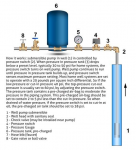To extend where JR made an excellent point.
If I’m overly
prolix, I apologize.
Well Pumps don’t have residual pressure that is omnipresent in the piping system. The only time it creates pressure is when the pump is pumping.
The thing that is important to realize is: Well pumps are not created equal.
There are two kinds of pumps. . . centrifugal and positive displacement pumps. Each model has different characteristic.
For most highly efficient systems--like fire pumps--this positive displacement type is desirable. It can work against the higher head pressure as opposed to centrifugal type.
Regardless of the type you choose for this application—the scenario as mentioned above is still the same.
No residual pressure exist when the pump is idle. Therefore, pressure switch or flow switch would NOT work, if at all.
Hammering in the system is not possible. Hammering is caused by trapped air that is getting compressed and decompressed inside a dead-end piping. This is not possible when you open a valve--- when pressure is relieved.
Totally submerged pumps are usually centrifugal, and pumps that are mounted above water level are positive displacement type.
Positive displacement pumps require priming since it is dealing with dry piping --while centrifugal pumps don’t need priming because they are submerged. They are controlled by float switch. . . running them dry could destroy them.
Centrifugal pumps PUSH water (or any liquid) while positive displacement pumps PULL or lift water to deliver. One is a
pusher the other one is a
sucker.
Positive displacement pumps can either be a gear pump , screw type pump (the Archimedes Type) --piston or diaphragm type-- and are more expensive,
Now, the above narrative doesn’t answer your question about : a control that can operate a motor when a valve is open or the pressure drops.
The answer is NO.
You cannot have a pressure drop when there is no pressure to contend with in the beginning. (Note JR's post)
NO VFD , Pressure switch, or Flow Switch can be installed that will work in this kind of environment.
There is a way to do this and accomplish the result-- but you are only asking whether a flow or pressure switch would work-- owing to the PARSIMONIOUS approach (what you have in mind) in carrying out this task. You don’t want to spend the money.

If this forum is capable of calling out past comments—this problem was brought up in the past.
It required some control to shut water feeding a watering (drinking ) tub for grazing cattle.
Something like three years ago.


